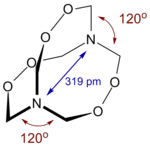Hexamethylene triperoxide diamine
 | |
| | |
| Names | |
|---|---|
| IUPAC names
3,4,8,9,12,13-Hexaoxa-1,6- diazabicyclo[4.4.4]tetradecane | |
| Identifiers | |
| 283-66-9 | |
| ChEMBL | ChEMBL346085 |
| ChemSpider | 55052 |
| |
| Jmol-3D images | Image |
| PubChem | 61101 |
| |
| Properties | |
| C6H12N2O6 | |
| Molar mass | 208.17 g/mol |
| Appearance | White crystalline solid |
| Density | 0.88 g/cm3 |
| Melting point | Decomposes at 75 °C Ignites spontaneously at 133 °C |
| Explosive data | |
| Shock sensitivity | High |
| Friction sensitivity | High |
| Detonation velocity | ~4511 m/s |
| RE factor | 0.8 |
| Except where noted otherwise, data is given for materials in their standard state (at 25 °C (77 °F), 100 kPa) | |
| | |
| Infobox references | |
Hexamethylene triperoxide diamine (HMTD) is a high explosive organic compound. The theorized structure lent itself well to acting as an initiating, or primary explosive. While still quite sensitive to shock and friction, it was relatively stable compared to other initiating explosives of the time, such as mercury fulminate, and proved to be relatively inexpensive and easy to synthesise. As such, it was quickly taken up as a primary explosive in mining applications.[1] However, it has since been superseded by even more stable compounds such as tetryl.
Preparation and structure
First synthesised in 1885 by Legler,[2] HMTD may be prepared by the reaction of an aqueous solution of hydrogen peroxide and hexamine in the presence of citric acid or dilute sulfuric acid as a catalyst.
The molecule adopts a cage-like structure.[3]
Properties as an explosive
No peroxide has found practical use as an explosive as a consequence of the weak oxygen-oxygen bond, which leads to poor thermal and chemical stability and a high sensitivity to shock (physical impact). Like other organic peroxides such as acetone peroxide, HMTD is unstable and detonates upon shock, friction, and heat. It is, however, less unstable than many other peroxides under normal conditions; exposure to ultraviolet light increases its sensitivity. It also reacts with most common metals, which can lead to detonation. HMTD is chemically very stable when pure (free of acids, bases, and metal ions) and does not quickly sublime like its acetone counterparts.
HMTD is a more powerful initiating explosive than mercury fulminate, but its poor thermal and chemical stability prevents its use in detonators.[4]
Terrorism
Despite no longer being used in any military application, and despite its shock sensitivity, HMTD remains a common home-made explosive and has been used in a large number of suicide bombings and other attacks throughout the world. For example, it was one of the components in the explosives intended to bomb Los Angeles International Airport in the 2000 millennium attack plots,[5][6] it was used in the 7 July 2005 London bombings,[7] and it was the planned explosive in the 2006 transatlantic aircraft plot.[8]
References
- ↑ Taylor, C. A.; Rinkenbach, W. H. Army Ordnance 1924. 5, 463–466
- ↑ Legler, L . (1885). "Ueber Producte der langsamen Verbrennung des Aethyläthers". Berichte der deutschen chemischen Gesellschaft 18 (2): 3343–3351. doi:10.1002/cber.188501802306.
- ↑ Schaefer, William P.; Fourkas, John T.; Tiemann, Bruce G. (April 1985). "Structure of hexamethylene triperoxide diamine". Journal of the American Chemical Society 107 (8): 2461–2463. doi:10.1021/ja00294a043.
- ↑ Hodgson,Robert ; Agrawal,Jai P. (2007). Organic Chemistry of Explosives. Wiley. p. 414.
- ↑ U.S. Court of Appeals for the Ninth Circuit (2 February 2010). "U.S. v. Ressam" (PDF). Retrieved 27 February 2010.
- ↑ "Complaint; U.S. v. Ressam" (PDF). NEFA Foundation. December 1999. Retrieved 26 February 2010.
- ↑ "London bombers used everyday materials" Reuters, 4 August 2005, Retrieved 16 April 2006
- ↑ Van Natta, Don, Jr.; Elaine Sciolino and Stephen Grey (28 August 2006). "Details Emerge in British Terror Case". The New York Times. Retrieved 7 February 2009.